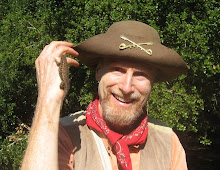The Eagle Creek Trail climbs above the redwoods and into the realm of a unique ecosystem of sand hills. These hills are made of sand that was deposited deep in the ocean 15 million years ago and then uplifted to their present location near Felton and Scotts Valley. Because the sand is too porous to retain moisture it is unsuitable for redwood trees. Instead, it is inhabited by ponderosa pines and an assemblage of drought resistant plants, some of which only grow in this environment.
From the Eagle Creek Trail we turned right (south) on the Pine Trail to a large overlook structure where we stopped for lunch. From here we could see the surrounding mountains and south to Monterey Bay. We also enjoyed watching acorn woodpeckers coming and going from a nesting cavity in a dead
ponderosa pine (woodpecker photo by Diana Gustafson). We then headed downhill to the west on the Ridge Fire Road, which goes through a thriving community of native plants following a recent controlled burn.
Heading west on the Ridge Fire Road we rapidly descended back into the second-growth redwood forest and then turned right (north) on the Rincon Fire Road. We then continued north on the River Trail, which parallels the San Lorenzo River. From there we walked the eastern half of the Redwood Grove Loop Trail as it lead us back to the trail head.
On this field trip we saw banana slugs, wild ginger, redwood violet, manzanita, sticky monkey flower, yerba santa, bush poppy, lupine, wild rose, redwood sorrel, Douglas iris, thimbleberry, and many other wildflowers.
After the hike most of our class walked to the Roaring Camp & Big Trees railroad a short distance to the east, where we saw the remains of an old steam donkey and sawmill, and enjoyed the noisy and steamy appearance of the narrow-gauge steam engine.
TO GET THERE... the main entrance is just south of Felton on Highway 1.









No comments:
Post a Comment